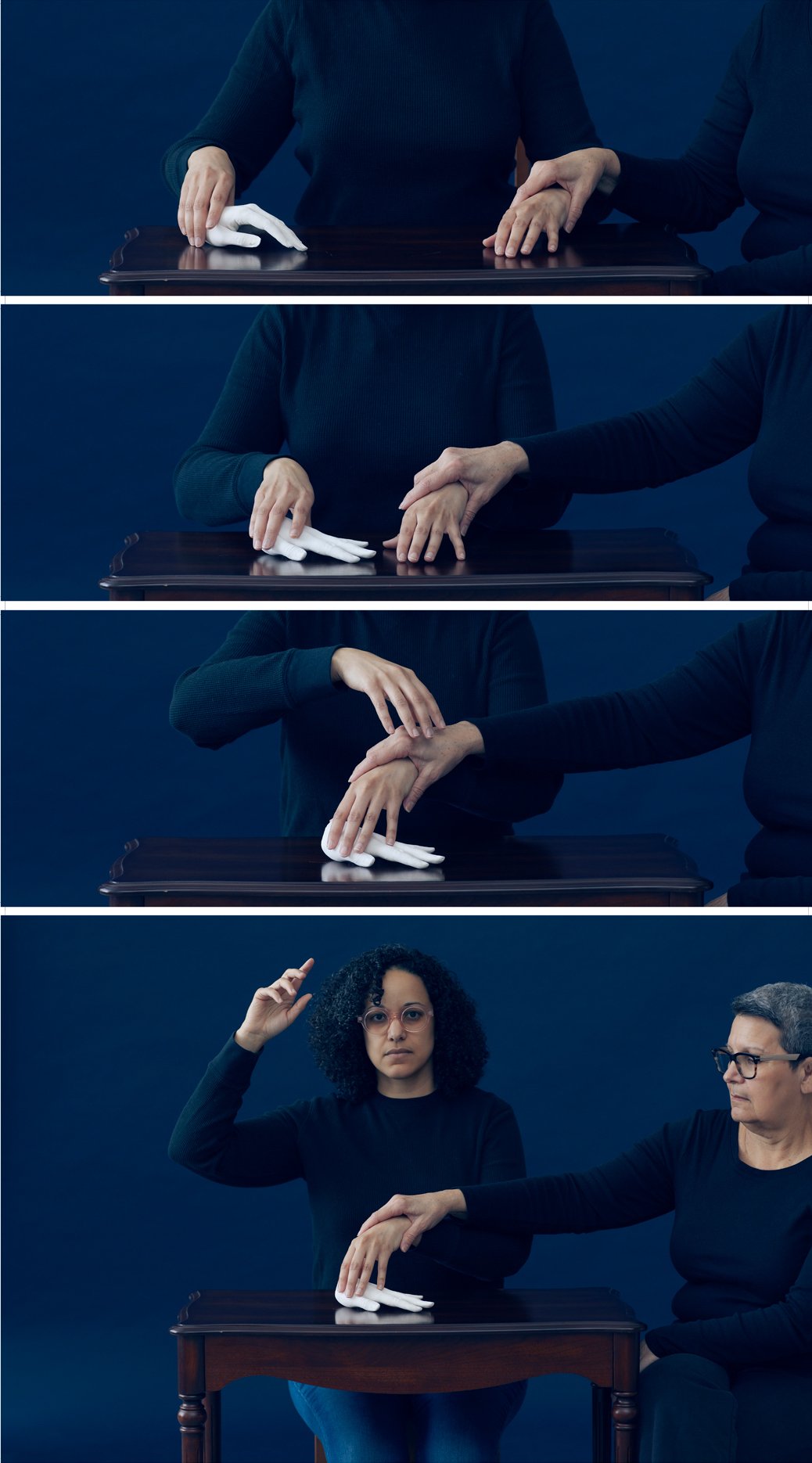To Mirror and To Hold: On Erika DeFreitas | Ashley Raghubir
February 13, 2024
Erika DeFreitas, arriver avant moi, devant moi, 2019–20
The foundation
never actually sets, the past
oozes from the pore of every stone– Shani Mootoo, Sometimes I Call You by My Father’s Name
An ever-present absence informs interdisciplinary artist Erika DeFreitas’s attention to the affirmation of presence. The ghostly permeates her practice: loss both encountered and anticipatory, spectral traces of personhood in the archive, gestures in memoriam to family. DeFreitas commonly presents us with hauntings more quotidian than fantastic. These are presences that are unconscious yet embodied, assuring, and, at times, sorrowful.
DeFreitas’s recent and largest solo exhibition to date it’s because of the shimmer, the verge, and the yet. at the Doris McCarthy Gallery was curated by Sandy Saad-Smith and spanned almost two decades of practice including performance, photography, video, and installation.
Questions of Inheritance | Port of Spain – Scarborough – Siparia
I have been troubled by an inherent feeling of belonging whenever I set foot on an island in the Caribbean . . . I have been wrestling with an anxiety that arose when attempting to understand how I can feel so grounded on a land that has never been “home” . . . Perhaps this intuitive feeling is one that is inherited.
– Erika DeFreitas, Alice Yard, 2017
The Black Madonnas of Great Echoes (2021–) is a series of photo-based collages of elaborately adorned Black Madonna figures. Each collage is presented on a single sheet of white paper, with a photographic portrait of a Black woman’s face surrounded by a halo of gold leaf. Layered upon each unique portrait is a black and white image of a specific Black Madonna’s face. The effect is that of a double, or a multiplicity, of each figure. DeFreitas has dressed the Black Madonnas in collaged images of colourful stones, large diamonds, gloved hands, and richly patterned and textured fabrics. In several, the body is merely suggested with a few paper gestures; opulence takes precedence over form.
Erika DeFreitas, The Black Madonnas of Great Echos, 2021–
DeFreitas learned of Black Madonnas in the summer of 2017, during an artist residency at Alice Yard in Port of Spain. There, she heard of a figure known as “La Divina Pastora,” in the town of Siparia on the island’s southern coast. Upon returning home, DeFreitas’s mother Cita shared that DeFreitas’s Trinidadian paternal grandmother cared for and adorned that same “La Divina Pastora.” DeFreitas met her grandmother – the mother of her estranged father – only twice, both instances as a young child visiting Trinidad. She shares: “I think that perhaps my interest in the Black Madonna was a way of my grandmother trying to forge a relationship with me.” DeFreitas responds by mirroring her grandmother’s model of devotion. As in The Impossible Speech Act (2007), and her other ongoing work with Cita, this series engages with intergenerational inheritance.
Erika DeFreitas, The Impossible Speech Act, 2007
Black Madonna historian Emma Maggie Solberg cites medieval historian Cord Whitaker’s concept of the “shimmer of blackness” in the medieval archive, which he characterizes as “simultaneous presence and nonpresence.” This vacillation between certainty and uncertainty informs Whitaker’s reading of Blackness’s shimmer in the archive and, in my reading, DeFreitas’s attempt at knowing a grandmother. I too have wondered about my Trinidadian paternal grandmother whom I also met only as a young child. What echoes, or shimmers, unattributed to her persist in me?
Witnessing Jeanne | Jacmel – Paris – Scarborough
I wanted to share space with her, to learn, to understand, and in a way, to keep her company. I wanted to let her know that she is seen.
– Erika DeFreitas, 2023
Erika Defreitas, arriver avant moi, devant moi, 2019–20
In the eight large image and text prints that form DeFreitas’s arriver avant moi, devant moi (2019–20), we see the artist’s hands on a worktable arranging and holding various materials including printed artwork reproductions, a hand-held mirror, and photographic framing devices. Below each photograph are handwritten phrases, quotes, and questions excerpted from DeFreitas’s notebook in relation to the subject of arriver avant moi, devant moi: Jeanne Duval. Born in Jacmel, Haiti, to parents of African and European ancestry, Duval is widely known for her time in Paris during a two-decades-long relationship with poet Charles Baudelaire. The arriver avant moi, devant moi series documents DeFreitas’s research-based process of artistic and art historical intervention into the erasure of Duval from Gustave Courbet’s group studio portrait L’Atelier du peintre (1855). Duval was originally depicted standing next to Baudelaire looking into a hand-held mirror, but her painted image was removed, purportedly at Baudelaire’s request, leaving only a spectral trace below layered varnish. DeFreitas cites contemporary artists Maud Sulter and Lorraine O’Grady, who have engaged with Duval’s absenting in their own practices, Sulter through self-portraiture dressed as Duval and O’Grady with side-by-side images of her mother and Duval at comparable ages. Interraciality connects not only DeFreitas to Duval, but DeFreitas to Sulter and O’Grady. DeFreitas states of Duval: “Our shared interraciality was a significant factor in what first drew me to Jeanne. I was so curious about this mixed race woman who lived in a time where stories like hers have been so hard to come across.”
In one print, DeFreitas pays homage to Sulter’s collaged Jeanne: A Melodrama (1994) by layering cut-outs of Édouard Manet’s Olympia (1863), Nadar’s mid-nineteenth century photograph of Duval, and a self-portrait of Sulter. In another print, DeFreitas holds a hand-held mirror that captures her own reflected image and replicates the original rendering of Duval in Courbet’s painting. Handwritten text below includes the phrases: “Maud joins me in this process,” and “there is a resonance.” In another print, DeFreitas’s hands hold a small photograph of herself standing in the Musée d’Orsay looking at Courbet’s L’Atelier du peintre. More than seeing, the work is a witnessing documented. Duval is held in the work’s images and handwritten notes.
What draws us to particular historical subjects and their resonances in the archive? I contend that it can be a noticing of one’s own personhood in another. DeFreitas, like Sulter and O’Grady, considers Duval’s subjectivity as an interracial Black Haitian woman in mid-nineteenth century Paris. In the work’s final image, DeFreitas traces a line on her own open palm, onto graph paper, and toward a map and photograph of Duval’s former Parisian residence with the handwritten script “again, again.” In arriver avant moi, devant moi, Black women’s presences are seen and reflected with particular attention to an interracial positionality, Black women artists’ works are cited, and art history is troubled and activated to gesture toward an affirming repair.
Erika DeFreitas, Everything repeats itself but all this has never happened before, 2019
On the Work We Are Drawn To | Scarborough – Toronto
it’s because of the shimmer, the verge, and the yet. presents a body of work that may be located in places and times both known and unknown to DeFreitas. Her works’ subjects include herself, her mother, as well as lasting ghosts. I see much of myself reflected in DeFreitas’s practice – beyond our shared interraciality, there are connections to Trinidad, a deep maternal closeness, and the grief of paternal estrangement. DeFreitas’s work holds the specific experiences of her personhood so tenderly while gesturing to the fulsome presences that precede and surround her.
Ashley Raghubir is a PhD candidate in the Department of Art History at the University of Toronto. Her doctoral research considers contemporary art of late twentieth and twenty-first century Trinidad and Guyana and their diasporas. Her writing has been published in Texte zur Kunst, C Magazine, and Momus.







